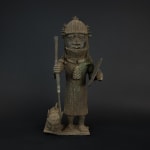Benin Bronze Figure of a Royal Attendant, 18th Century -19th Century
Bronze
41 x 16 x 12 cm
16 1/8 x 6 1/4 x 4 3/4 in
16 1/8 x 6 1/4 x 4 3/4 in
ES.6431
Further images
The kingdom of Benin produced some of the finest artists and craftsmen in the history of the African continent. Yet this heritage was scarcely recognised until the British punitive expedition...
The kingdom of Benin produced some of the finest artists and craftsmen in the history of the African continent. Yet this heritage was scarcely recognised until the British punitive expedition of 1897, which destroyed and looted the ancient city compounds and in so doing brought the achievements of Benin to the world’s attention. The foundation of the Benin peoples was contemporary with the European late mediaeval period, when the kingdom of Benin was founded by a descendent of an Ife king in c. 1180 CE. In the 15th and 16th centuries the power of the empire stretched across most of West Africa, and those areas not under their control were indirectly influenced by the effect of their trade networks and artistic achievements. Until the late 19th century, the Benin centres were a ruling power in Nigeria, dominating trade routes and amassing enormous wealth as the military and economic leaders of their ancient empire.
Benin art was designed to venerate the achievements and/or memory of the Obas, the divine rulers of the Benin polities. Benin work in bronze and copper, ironworking and sculpting in a range of materials that particularly included ivory was extremely refined and effective; indeed, smelting, forging and cire perdue (lost wax) metalworking methods exceeded any seen in Europe until the 19th century. The palace walls were decorated with ornate metal plaques, while dead Obas were honoured by erecting commemorative altars, framed by elephant tusks mounted in brass heads, and further decorated with brass leopards, spears, statues, tableaux (depicting the Oba and his followers) and rattle-staffs (ukhurhe). Perhaps the most unusual items to grace the kingly altars were the bells, which were rung in order to awaken the spirits.
This stunning bronze sculpture represents a royal attendants, a specific character of great importance in the ritual system of the kingdom of Benin, especially during the annual apparition of the Oba outside the palace, when he presented himself to his people flanked by attendants. This particular ceremonial is attested since at least the 17th century. The royal connection of the figure is evidenced by the presence of a leopard cub, on the most poignant royal iconographies in Benin. The Oba (King) of Benin was a sacred figure for his people, a living embodiment of a powerful link between this world and the eternal one of ancestors and gods. The Oba was traditionally referred to as “the leopard of the house”, and representations of beautiful, majestic, and fierce leopards appear frequently in the royal art of Benin. The symbolical meaning of the royal iconography of the leopard implied two different aspects: the first one was that the Oba was able to dominate wilderness with his strength, and therefore protect his people; secondly, the leopard embodied the fierceness and majesty of the King of Benin, who was deemed by his people to be almost supernatural figure, placed above the worldly cares and limitations of human nature.
This is an exceptional piece of African art, befitting the most discerning collectors.
Benin art was designed to venerate the achievements and/or memory of the Obas, the divine rulers of the Benin polities. Benin work in bronze and copper, ironworking and sculpting in a range of materials that particularly included ivory was extremely refined and effective; indeed, smelting, forging and cire perdue (lost wax) metalworking methods exceeded any seen in Europe until the 19th century. The palace walls were decorated with ornate metal plaques, while dead Obas were honoured by erecting commemorative altars, framed by elephant tusks mounted in brass heads, and further decorated with brass leopards, spears, statues, tableaux (depicting the Oba and his followers) and rattle-staffs (ukhurhe). Perhaps the most unusual items to grace the kingly altars were the bells, which were rung in order to awaken the spirits.
This stunning bronze sculpture represents a royal attendants, a specific character of great importance in the ritual system of the kingdom of Benin, especially during the annual apparition of the Oba outside the palace, when he presented himself to his people flanked by attendants. This particular ceremonial is attested since at least the 17th century. The royal connection of the figure is evidenced by the presence of a leopard cub, on the most poignant royal iconographies in Benin. The Oba (King) of Benin was a sacred figure for his people, a living embodiment of a powerful link between this world and the eternal one of ancestors and gods. The Oba was traditionally referred to as “the leopard of the house”, and representations of beautiful, majestic, and fierce leopards appear frequently in the royal art of Benin. The symbolical meaning of the royal iconography of the leopard implied two different aspects: the first one was that the Oba was able to dominate wilderness with his strength, and therefore protect his people; secondly, the leopard embodied the fierceness and majesty of the King of Benin, who was deemed by his people to be almost supernatural figure, placed above the worldly cares and limitations of human nature.
This is an exceptional piece of African art, befitting the most discerning collectors.







